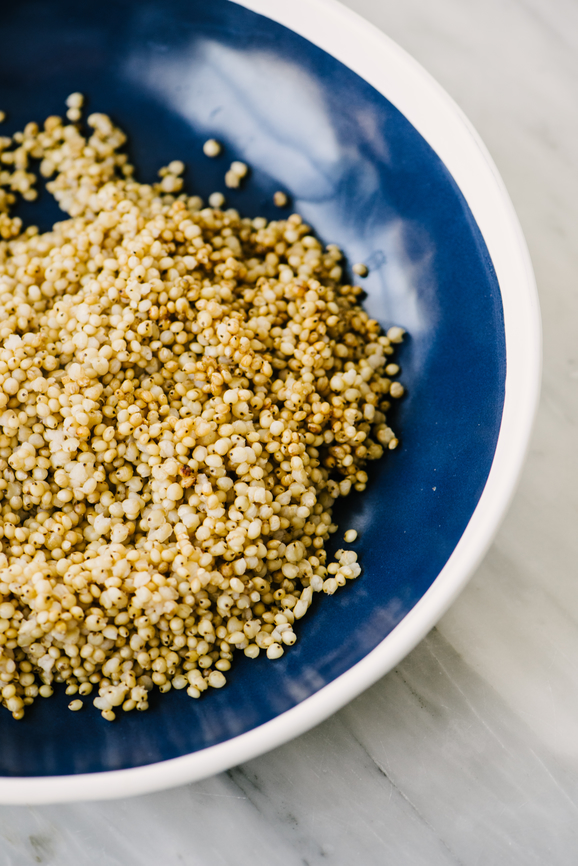How to Cut Back on Meat Without Sacrificing Your Protein Intake!

Been thinking about cutting out meat but are worried about not getting enough protein?
In my practice I’ve learned that many people think they can’t get enough protein if they only eat plants or follow a plant forward pattern of eating. I’m here to tell you- you can absolutely meet your protein needs with plants. I want to share my favorite plant based proteins with you.
Protein is an essential macronutrient (meaning we need to get it from the foods and drinks we consume) that the body needs in order to repair cells, build muscles, and grow hair, nails, and bones, among other functions1. Protein is made from amino acids, nine of which are essential and must come from food1. The Academy of Nutrition and Dietetics recommends that the average person should consume 0.8 grams of protein per kilogram1. Depending on the individual, this would be around a hand-sized portion or two at each meal. You can find amino acids in both animal sources (i.e. meats, milk, fish, and eggs) and plant sources (i.e. beans, legumes, nuts, seeds, wheat germ, and some ancient grains like quinoa or fonio).
Animal-based proteins are considered complete proteins because they contain all nine of the essential amino acids. Most plant-based proteins are considered incomplete proteins because they lack one or more essential amino acids2. However, as previously mentioned there are some ancient grains that have the full amino acid profile. With that said, you do not need to eat animal products to meet your daily protein needs2,3.
Here are my 3 favorite plant-based proteins:
1. Ancient Pseudocereals (quinoa, amaranth, buckwheat) – fancy way of saying ancient grains!
I love these ancient grains, quinoa, amaranth, and buckwheat not only for their versatility but also because they are considered complete proteins. These ancient grains come from the seeds of Chenopodium, Amaranthus, and Fagopyrum esculentum plants, and are similar in terms of nutritional value to rice and corn4.
In terms of protein content, one cup of cooked quinoa provides approximately 8 grams of protein, one cup of cooked amaranth provides 9 grams of protein, and one cup of buckwheat provides 6 grams of protein 5,6,7.
Quinoa, amaranth, and buckwheat can be prepared and enjoyed in various ways including breakfast porridge, and popcorn. Check out this recipe for Breakfast Porridge.
2. Whole and minimally processed soy products ( tofu, tempeh, and edamame)
Similar to pseudocereals, soy has all nine essential amino acids and is a complete protein. Tofu is made from condensed soy milk that is pressed into white blocks and come in .different textures (i.e. silken, firm, and extra-firm) that allows it to be cooked in various ways (e.g. as eggs in a breakfast scramble or as vegan “chicken” wings).
In terms of protein content, a half a cup of tofu has approximately 10 grams of protein 8. Tempeh is made from fermented soybeans. One cup of tempeh has approximately 24 grams of protein9. Tempeh is versatile and can be made into burgers, stuffed peppers, and vegan meatballs.
Lastly, edamame are immature soybeans that are usually steamed or boiled and can also be used as a base for hummus. Half of a cup of edamame has 8 grams of protein10. That’s around the size of 1/3 of a deck of cards. Edamame can be eaten on its own as a snack or added to a grain bowl, salad, or soup.
3. Legumes
Legumes are seeds from the plant of the Leguminosae or Fabaceae family and include lentils, beans, peas, and peanuts 11.
In terms of protein content, one cup of lentils contains 18 grams of protein, one cup of white beans contains 17 grams of protein, and one cup of split peas contains 16 grams of proteins 12,13,14. That would be similar in size to an entire deck of cards 18.
When eaten alone, legumes are considered incomplete proteins and should be paired with another incomplete protein to make the full amino acid profile. For example, pairing beans with rice makes a complete protein. Legumes can also be paired with complete proteins to yield a complete source of all essential amino acids (e.g. split pea soup with tofu or lentil and beef stew). Here’s a great Instant Pot Stew recipe. Basically any way you choose to eat them is great!
As you can see there are many plant-based sources of protein and many ways to enjoy them. Research tells us that decreasing your animal protein and increasing your plant-based protein will decrease your chances of heart disease, improve your digestion, and give you more energy to name just a few of the benefits.
The next time you are cooking, think about the plant-based proteins that you already know and try to add them to your meal. To start cutting out animal protein and increasing your plant-based protein, try for two dinners a week meat-free and replace your protein with one of the suggestions above!
References
- https://www.eatright.org/food/nutrition/dietary-guidelines-and-myplate/how-much-protein-should-i-eat
- https://www.rchsd.org/health-articles/what-does-getting-complete-proteins-mean-for-vegetarians/ (or https://medlineplus.gov/ency/article/002467.htm)
- https://pubmed.ncbi.nlm.nih.gov/27886704/
- https://www.ncbi.nlm.nih.gov/pmc/articles/PMC5977093/
- https://fdc.nal.usda.gov/fdc-app.html#/food-details/168917/nutrients
- https://fdc.nal.usda.gov/fdc-app.html#/food-details/170683/nutrients
- https://fdc.nal.usda.gov/fdc-app.html#/food-details/170686/nutrients
- https://fdc.nal.usda.gov/fdc-app.html#/food-details/172476/nutrients
- https://foodandnutrition.org/september-october-2013/beans-pantry-staples-nutrition-stars
- https://fdc.nal.usda.gov/fdc-app.html#/food-details/172421/nutrients
- https://fdc.nal.usda.gov/fdc-app.html#/food-details/551175/nutrients
- https://fdc.nal.usda.gov/fdc-app.html#/food-details/172429/nutrients
- https://fdc.nal.usda.gov/fdc-app.html#/food-details/174272/nutrients
- https://fdc.nal.usda.gov/fdc-app.html#/food-details/542288/nutrients
- https://pubmed.ncbi.nlm.nih.gov/32231103/
- https://link.springer.com/article/10.1007%2Fs11883-016-0624-z
- https://jamanetwork.com/journals/jamainternalmedicine/article-abstract/2768358
- https://www.hopkinsmedicine.org/bariatrics/_documents/nutrition_protein_content_common_foods.pdf



Leave a Reply